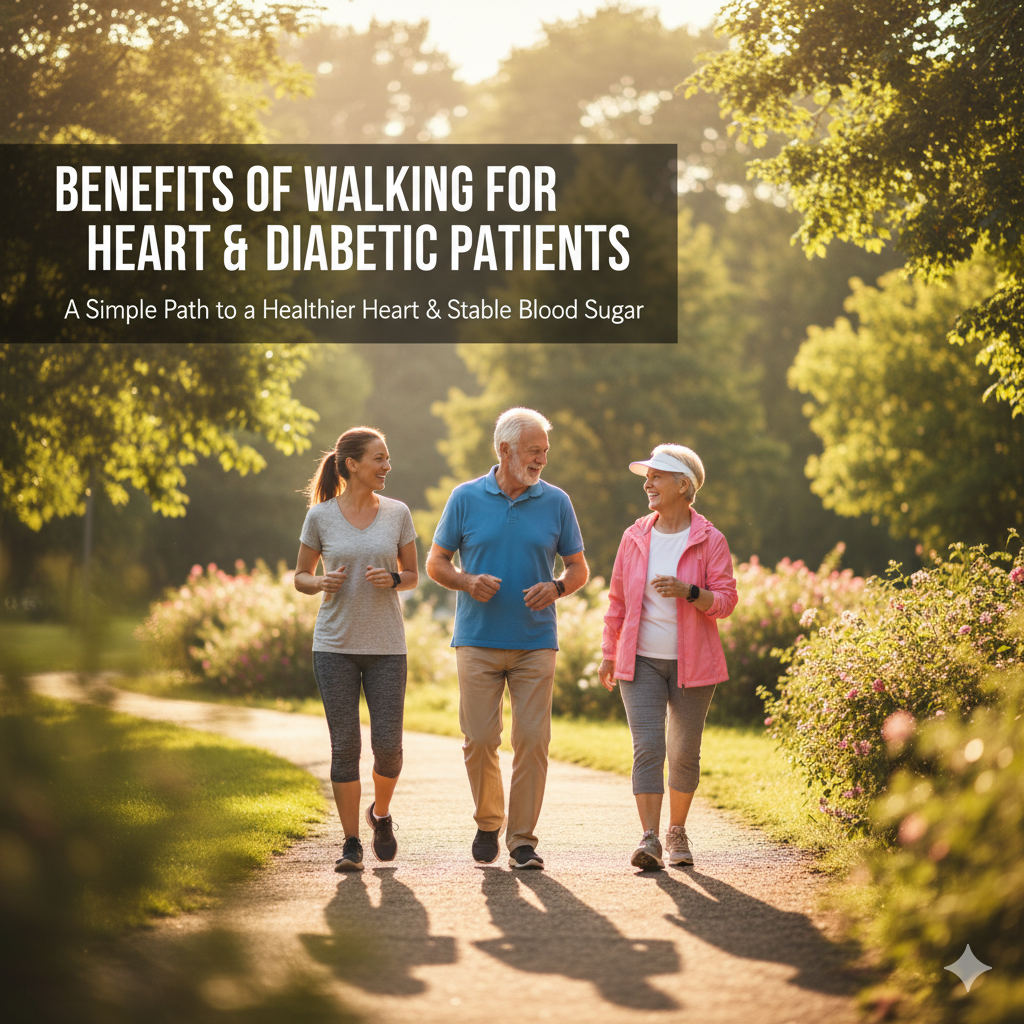Benefits of Walking for Heart and Diabetic Patients
Introduction
In today’s fast-paced world, lifestyle diseases like heart disease and diabetes are becoming increasingly common. Both conditions are heavily influenced by physical inactivity, unhealthy diet, and stress. However, the solution to preventing and managing these chronic illnesses doesn’t always lie in expensive treatments or gym memberships — it can begin with something as simple as walking.

Walking is one of the most accessible and effective forms of exercise. It requires no equipment, can be done anywhere, and offers countless health benefits, especially for people with heart conditions or diabetes. Regular walking helps regulate blood pressure, improve cholesterol levels, boost circulation, enhance insulin sensitivity, and manage body weight — all key factors in maintaining cardiovascular and metabolic health.
This article explores the science-backed benefits of walking for heart and diabetic patients, along with practical tips and complementary exercises for a holistic health routine.
🫀 Section 1: Walking and Heart Health
Heart disease is one of the leading causes of death globally, but it’s also one of the most preventable. Regular physical activity like walking has a profound impact on cardiovascular health.
1.1 Improves Circulation and Lowers Blood Pressure
Walking increases your heart rate and enhances blood flow throughout the body. As circulation improves, the heart pumps blood more efficiently, reducing strain on the arteries.
Research shows that brisk walking for at least 30 minutes a day, five times a week can significantly reduce systolic and diastolic blood pressure. Over time, this simple habit lowers the risk of developing hypertension, a major risk factor for heart attacks and strokes.
1.2 Balances Cholesterol Levels
A sedentary lifestyle is closely linked to high LDL (bad cholesterol) and low HDL (good cholesterol) levels — a combination that accelerates plaque buildup in arteries.
Walking helps reverse this trend. Studies have shown that regular walkers experience:
- A drop in LDL levels (which cause arterial blockage), and
- An increase in HDL levels (which remove bad cholesterol from the bloodstream).
As a result, arteries remain clearer, and the risk of atherosclerosis (narrowing of arteries) decreases.
1.3 Strengthens the Heart Muscle
The heart, like any other muscle, becomes stronger and more efficient with regular aerobic exercise. Brisk walking enhances cardiac output, ensuring that each heartbeat pumps more oxygen-rich blood throughout the body.
This not only improves cardiorespiratory endurance but also lowers resting heart rate, which is a marker of improved heart efficiency.
1.4 Reduces Risk of Heart Attack and Stroke
Regular walking improves endothelial function (the lining of blood vessels) and lowers systemic inflammation, both crucial for vascular health. According to the American Heart Association, people who walk at least 150 minutes per week have a significantly reduced risk of coronary heart disease, stroke, and heart failure.
1.5 Supports Recovery After Cardiac Events
For patients who have experienced a heart attack or undergone heart surgery, walking-based cardiac rehabilitation programs are often recommended. Gentle walking helps rebuild stamina, strengthens the cardiovascular system, and boosts confidence during recovery.
🍎 Section 2: Walking and Diabetes Management
Diabetes, particularly type 2 diabetes, is closely tied to lifestyle habits. Physical activity such as walking plays a key role in blood glucose regulation and insulin sensitivity.
2.1 Enhances Insulin Sensitivity
Insulin resistance is the root cause of type 2 diabetes. Walking stimulates muscle activity, which increases glucose uptake from the blood into muscle cells without requiring additional insulin.
Even a 15–20-minute walk after meals can help reduce postprandial glucose spikes — one of the main triggers for long-term diabetic complications.
2.2 Helps Maintain Blood Sugar Levels
Walking aids in controlling blood glucose by promoting efficient metabolism of carbohydrates. Consistent walking reduces HbA1c levels, a long-term indicator of blood sugar control. This benefit has been confirmed by numerous studies showing that moderate exercise improves glycemic control as effectively as some oral anti-diabetic medications.
2.3 Aids Weight Management
Weight management is vital for diabetic patients, as excess body fat — especially visceral fat — increases insulin resistance.
Brisk walking burns calories, promotes fat loss, and helps maintain a healthy Body Mass Index (BMI). Even walking 5 km per day can result in significant weight reduction over time, improving insulin sensitivity and metabolic health.
2.4 Improves Circulation and Reduces Diabetic Complications
Poor blood circulation is common among diabetic individuals and can lead to complications like neuropathy, nephropathy, and retinopathy. Regular walking improves circulation, reduces inflammation, and helps prevent vascular damage.
2.5 Boosts Mental Health and Reduces Stress
Stress elevates cortisol levels, which in turn raises blood glucose. Walking, especially outdoors in natural surroundings, promotes the release of endorphins and serotonin, which help lower stress and improve mental well-being — both important aspects of diabetes care.
⏱️ Section 3: Recommended Walking Routine
To achieve maximum benefits, diabetic and heart patients should follow a structured yet flexible walking routine based on their fitness level and medical condition.
| Goal | Frequency | Duration | Intensity |
|---|---|---|---|
| General health | 5 days/week | 30 min/day | Moderate (brisk pace, can talk but not sing) |
| Weight loss | 5–6 days/week | 45–60 min/day | Brisk to vigorous |
| Blood sugar control | Daily | 15–30 min after meals | Moderate |
| Cardiac rehabilitation | 4–5 days/week | 20–40 min/day | Low to moderate (doctor-supervised) |
Tips for Success
- Start slow: Begin with 10–15 minutes daily, then increase duration gradually.
- Use a pedometer or smartwatch: Aim for 7,000–10,000 steps per day, adjusted to your condition.
- Stay consistent: Regularity is more important than intensity.
- Choose comfortable terrain: Avoid steep slopes initially; flat surfaces are ideal for beginners.
💪 Section 4: Complementary Exercises Along with Walking
While walking is excellent, adding a few light exercises enhances strength, flexibility, and balance — essential for overall fitness, especially in older adults or those with chronic conditions.
4.1 Warm-up Exercises (5–10 minutes)
Before walking, warm up to prevent muscle strain and prepare the body:
- Gentle arm circles
- Shoulder rolls
- Neck rotations
- Hip twists
- Ankle flexing and stretching
4.2 Strengthening Exercises (2–3 times a week)
Building muscle improves insulin sensitivity and supports the cardiovascular system.
- Wall push-ups: Great for upper body strength without stress on the joints.
- Chair squats: Strengthens legs and improves balance.
- Step-ups: Use a staircase or low platform to activate core and leg muscles.
- Resistance band exercises: Low-impact way to tone muscles safely.
4.3 Flexibility and Balance Exercises
Flexibility reduces stiffness and improves posture — beneficial for heart patients and diabetics.
- Heel-to-toe walking: Enhances coordination and stability.
- Calf and hamstring stretches: Keeps muscles supple.
- Yoga and Tai Chi: Improve flexibility, mindfulness, and blood flow.
4.4 Cool-down Routine
End each walk with 5 minutes of gentle stretching or deep breathing to normalize heart rate and relax muscles.
⚠️ Section 5: Safety Tips for Heart and Diabetic Patients
While walking is generally safe, it’s important to take precautions to prevent complications.
- Consult your doctor before starting any new exercise program, especially if you have existing heart conditions, high blood pressure, or uncontrolled diabetes.
- Check blood sugar before and after walking. Carry a small snack if you’re prone to hypoglycemia.
- Wear comfortable, supportive shoes to prevent blisters and foot ulcers (especially in diabetics).
- Stay hydrated — drink water before, during, and after your walk.
- Avoid walking in extreme heat or cold, which can strain the heart and alter blood sugar levels.
- Listen to your body: Stop immediately if you experience dizziness, chest pain, severe fatigue, or shortness of breath.
- Walk with a companion or in safe, well-lit areas if possible.
🧘 Section 6: The Mind-Body Connection
Physical and mental health are deeply intertwined. Stress, anxiety, and depression are common among heart and diabetic patients, often worsening their physical conditions. Walking acts as a natural stress reliever by:
- Reducing levels of cortisol and adrenaline,
- Promoting endorphin release,
- Enhancing sleep quality, and
- Encouraging mindfulness and emotional balance.
Even a short morning or evening walk can serve as meditation in motion — a time to disconnect from worries and reconnect with oneself.
🌿 Section 7: Lifestyle Tips to Enhance the Benefits of Walking
To maximize the positive effects of walking:
- Eat a balanced diet: Emphasize whole grains, fruits, vegetables, lean proteins, and healthy fats.
- Avoid smoking and excessive alcohol consumption.
- Get regular medical check-ups: Monitor blood sugar, cholesterol, and blood pressure.
- Stay consistent: Even 20 minutes a day can make a long-term difference.
- Track progress: Keep a walking diary or use apps to monitor steps and motivation.
✅ Conclusion
Walking is truly a medicine in motion — an easy, low-cost, and highly effective way to prevent and manage heart disease and diabetes. It enhances cardiovascular function, improves blood glucose control, strengthens muscles, reduces stress, and boosts overall well-being.
For both heart and diabetic patients, consistency matters more than intensity. A daily walk — whether it’s around your neighborhood, a park, or even at home — can add years to your life and life to your years. Remember: Every step counts toward a healthier heart and a balanced life.
For more regular updates you can visit our social media accounts,
Instagram: Follow us
Facebook: Follow us
WhatsApp: Join us
Telegram: Join us



